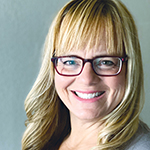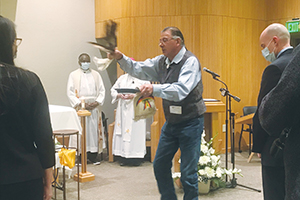By JULIE MINDA
Staff at ministry facilities that serve relatively large populations of Native Americans say that they have been aiming during the pandemic, as in usual times, to accommodate spiritual and cultural practices and preferences of their Native American patients. The spiritual practices of Native Americans can vary greatly by tribe and by individual.

Brannon
Karen Brannon is spiritual care manager for SCL Health's St. Vincent Healthcare in Billings, Montana. She says Native American patients often ask to have a spiritual leader or healer present in their hospital room to pray and perform sacred ceremonies. But visitation restrictions for hospitalized COVID patients generally prohibit such in-person visits from outside clergy or spiritual care practitioners.
The hospital's spiritual care team talks with patients and their family members and tribal spiritual care providers to determine how religious rituals and sacraments that are meaningful to individual patients can be adapted to be compliant with COVID infection protocols.

William Big Day, of a Montana Crow tribe, performs a ceremonial ritual during a service at St. Vincent Healthcare in Billings, Montana. The February service involved hospital leadership, Crow and Northern Cheyenne tribal members and Bishop Michael Warfel of the Diocese of Great Falls and Billings. Service participants honored those who have died of COVID, prayed for survivors and recognized staff's commitment to care.
Gordon Jackson, St. Vincent's health disparities program coordinator, notes that for many Native American patients, technology workarounds — such as videoconference sessions — do not carry the same spiritual weight or meaning as in-person ceremonies. In those situations, the hospital has arranged window visits between patients and spiritual healers.
Leroy "J.R." LaPlante directs the American Indian Health Initiative of Sioux Falls, South Dakota's Avera Health. He says many Native Americans in Avera's service areas are part of Lakota, Dakota, and Nakota Sioux tribes. Many practice a ritual commonly called "smudging," and termed Waziliya by these tribes, to clear a space of negative events and thoughts or to
welcome positive spiritual energy.
The ritual normally includes spoken prayers and the burning of sacred medicines such as sage, cedar, sweet grass and tobacco or a combination of those plants. The materials are rolled into a ball and put in a fireproof container and lit to create a smoke and fragrance. LaPlante says the concept is similar to the incense used by Catholics. He says the rising of the smoke and the fragrance are reminders that prayers are rising to the creator.
Small gatherings of relatives and the sick person usually participate in the Waziliya ritual. A ceremonial leader does not have to be present. LaPlante says chaplain services departments at Avera hospitals can supply the organic ingredients and a properly ventilated room to clear the fragrant smoke. Some facilities have designed rooms specifically for this purpose.
LaPlante says because infection prevention protocols during COVID made it difficult to hold Waziliya rituals, many Native American families have relied on another common spiritual practice to provide spiritual intervention for their loved ones in the hospital.
Under the practice, a ceremonial leader wraps tobacco or other plant material in colored broadcloth and ties the bundle and blesses it in a sweat lodge ritual called an inipi ceremony. Relatives of a sick person will place the blessed bundle near their loved one, often on the hospital bed where it remains until the patient takes it home. The sacred bundle is returned to the ceremonial leader and often put in a sacred place.
Extended family
St. Vincent's Brannon notes that many Native American people define family quite broadly. Family for American Indians often includes multiple extended family members who maintain a presence throughout a hospital stay, as compared to Caucasian families who tend to have more of an inner circle of immediate family visiting and perhaps not remaining present for the entirety of the patient's stay.
With COVID restrictions barring such extended visitation and visitation by large groups, spiritual care team members and clinicians have tried to find ways to connect Native American patients by phone, televisits or window visits to all the family they wish to see, just as the team does for all patients.
LaPlante says the communitarian aspect of Native American life has presented some challenges for Avera amid the pandemic especially when it comes to end-of-life care consults for those patients who are unable to have in-person visitors. It is usual for Native Americans to involve their extended family in important medical decisions. Spiritual care teams and others have been grappling with how to incorporate everyone who seeks to be involved in such decisions when they cannot meet in-person to talk due to COVID restrictions.
St. Vincent's Jackson notes that while videoconferencing technology has come to play an important role in uniting patients with loved ones when in-person visitation is barred, a greater proportion of Native Americans than Caucasians lack access to online connections. Jackson adds internet access is often limited on remote rural reservations. Many Native families cannot afford to purchase computers, smartphones or the internet subscriptions that are required for those devices.
Open minds
While cultural awareness and diversity education at Avera and St. Vincent's teach about heritage and the traditions of indigenous tribes, the education also underscores the importance of dispelling stereotypes, recognizing members of tribes as individuals worthy of respect, and adhering to their personal preferences and care goals.
LaPlante and Jackson say they regularly educate colleagues about Native American culture, spirituality and practices. LaPlante notes that he spends extra time doing so with chaplains, so they can know how to communicate with Native American patients about their spiritual preferences.
LaPlante recalls a relatively recent situation in which a Lakota patient was in an Avera hospital, unconscious. Her husband had brought in a spiritual article, blessed in an inipi ceremony, and had left it on her bed, in line with the couple's spiritual practices. When the woman was discharged, the couple found that a nurse had put the ceremonial article into the patient's luggage while the patient was unconscious.
"The nurse didn't realize that this was a mistake," and so it was an education process to help the nurse to understand the practice and the appropriate way to handle such articles, LaPlante says.
He adds that cultural competence education is an ongoing process that includes everyone gaining a better understanding of both the differences and similarities between themselves and the patients they serve.